
Lathyrus latifolius, the perennial peavine, perennial pea, broad-leaved everlasting-pea, or just everlasting pea, is a robust, sprawling herbaceous perennial flowering plant in the pea family Fabaceae. It is native to Europe but is present on other continents, such as North America and Australia, where it is most often seen along roadsides.
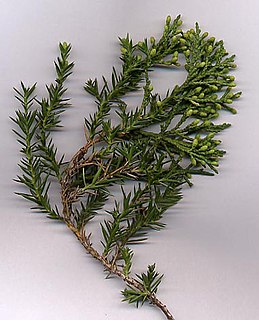
Juniperus chinensis, the Chinese juniper is a species of plant in the cypress family Cupressaceae, native to China, Myanmar, Japan, Korea and the Russian Far East. Growing 1–20 metres tall, it is a very variable coniferous evergreen tree or shrub.

Dianthus chinensis, commonly known as rainbow pink or China pink is a species of Dianthus native to northern China, Korea, Mongolia, and southeastern Russia. It is a herbaceous perennial plant growing to 30–50 cm tall.

Astilbe is a genus of 18 species of rhizomatous flowering plants within the family Saxifragaceae, native to mountain ravines and woodlands in Asia and North America. Some species are known by the common names false goat's beard and false spirea.
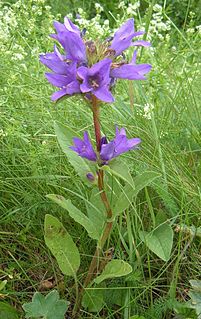
Campanula glomerata, known by the common names clustered bellflower or Dane's blood, is a species of flowering plant in the genus Campanula, belonging to the family Campanulaceae. It is the county flower of Rutland, England.

Geranium sylvaticum, the wood cranesbill or woodland geranium, is a species of hardy flowering plant in the family Geraniaceae, native to Europe and northern Turkey.

Cardamine pentaphyllos, the five-leaflet bitter-cress or showy toothwort, is a flowering plant in the family Brassicaceae, native to Western and Central Europe in Slovenia and Croatia. It is an herbaceous perennial, growing to 30–50 cm (12–20 in), with palmate leaves and racemes of purple, pink or white flowers in late Spring and early Summer.
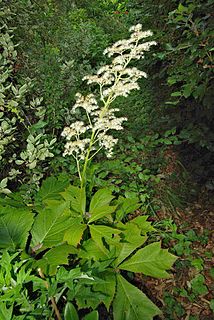
Rodgersia is a genus of flowering plants in the Saxifragaceae family. Rodgersia are herbaceous perennials originating from east Asia.

Filipendula rubra, also known as queen-of-the-prairie, is a species of flowering plant in the family Rosaceae native to the northeastern and central United States and southeastern Canada. It prefers full sun or partial shade and moist soil, but tolerates drier soil in a shadier location. It grows tall and firm, and produces blooms that are tiny and pink above its ferny, pointy leaves.

Saxifraga stolonifera is a perennial flowering plant known by several common names, including creeping saxifrage, strawberry saxifrage, creeping rockfoil, Aaron's beard, mother of thousands, roving sailor, and strawberry begonia or strawberry geranium.
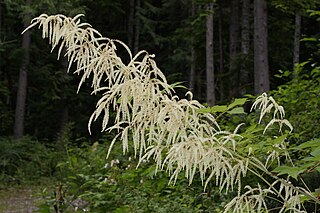
Aruncus dioicus, known as goat's beard, buck's-beard or bride's feathers, is a flowering herbaceous perennial plant in the family Rosaceae, and is the type species of the genus Aruncus. It has alternate, pinnately compound leaves, on thin, stiff stems, with plumes of feathery white or cream flowers borne in summer. This plant can be found in moist woodland, often at higher altitudes, throughout temperate areas of Europe, Asia, and eastern and western North America. In the UK it is considered suitable for planting in and around water areas, and has gained the Royal Horticultural Society's Award of Garden Merit.

Hylotelephium spectabile is a species of flowering plant in the stonecrop family Crassulaceae, native to China and Korea. Its common names include showy stonecrop, iceplant, and butterfly stonecrop.

Geranium dalmaticum, commonly called Dalmatian cranesbill, is a species of hardy flowering herbaceous perennial plant in the genus Geranium of the family Geraniaceae. It is native to Dalmatia on the west coast of Croatia. Growing to only 10 cm (3.9 in) tall by up to 50 cm (20 in) broad, it is cultivated as a garden subject in temperate regions for its low mound of aromatic leaves and soft mauve colored flowers. The palmately lobed glossy green leaves are tinted red in the Autumn. It has gained the Royal Horticultural Society's Award of Garden Merit.

Paeonia officinalis, the common peony, or garden peony, is a species of flowering plant in the family Paeoniaceae, native to mainly mountainous areas of Southern Europe and introduced in Central and Western Europe and North America.

Eriocapitella hupehensis, a species of flowering plant in the buttercup family Ranunculaceae, is native to Asia. The specific epithet hupehensis, which means "from Hupeh province, China", refers to a region where the species is known to occur. In Chinese, it is called dǎ pò wǎn huā huā (打破碗花花), which means "broken bowl flower".
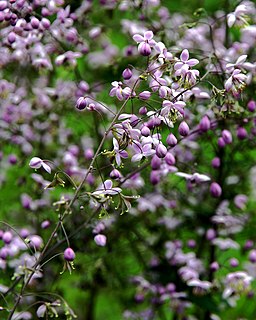
Thalictrum delavayi, Chinese meadow-rue, is a species of flowering plant in the family Ranunculaceae native to China. Growing to 1.2 m (4 ft) tall by 60 cm (24 in) wide, it is a herbaceous perennial with leaves divided into many small leaflets, and panicles of lilac flowers with green or white stamens in summer.

Rodgersia pinnata is a species of flowering plant in the family Saxifragaceae, native to the Sichuan and Yunnan provinces of China. It is a robust, herbaceous perennial growing to 120 cm (47 in) tall by 75 cm (30 in) broad, with textured palmate/pinnate leaves up to 90 cm (35 in) long, with 5-9 leaflets. 60 cm (24 in) erect panicles made up of tiny, star-shaped flowers, are borne on reddish green stems in summer. The flowers are white.

Astrantia major, the great masterwort, is a species of flowering plant in the family Apiaceae, native to central and eastern Europe. Growing to 90 cm (35 in) tall by 45 cm (18 in) broad, it is an herbaceous perennial, much used in gardens.

Prunus davidiana is a species in the genus Prunus in the family Rosaceae. It is also known by the common names David's peach and Chinese wild peach. It is native to China, preferring to grow in forests and thickets, on slopes in mountain valleys, and in waste fields, from 800 to 3200 m. It is resistant to frost, and to a number of pests and diseases of cultivated peach, and is the subject of many studies for the genetic improvement of peaches.
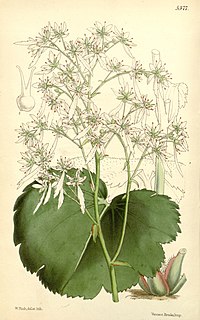
Saxifraga fortunei (齿瓣虎耳草), the fortune saxifrage, is a species of flowering plant in the family Saxifragaceae, native to China, Japan and Korea. Growing to just 40 cm (16 in) tall and broad, it is a shade-loving herbaceous perennial with large round fleshy leaves. Slender branched stalks bear panicles of small white starry flowers in summer. The two lower petals of each bloom are significantly longer than the others. Both the flowers and the leaves are sometimes flushed red or pink.























